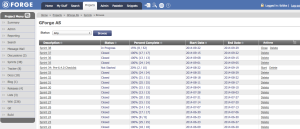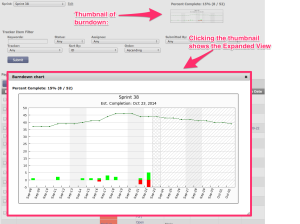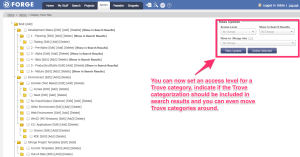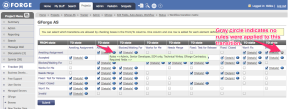Preview of GForge v6.4.0
We have been pretty quiet this summer regarding the work progress we’ve made on GForge but that is going to change dramatically. We will be making two big releases before the end of the year and in the coming weeks and we’ll be sharing all the details here.
The first big development is the work we’ve done on the next generation of GForge. This past spring we started a complete redesign of GForge taking care to include the features our customers have grown to love while ensuring a pleasurable and efficient experience for our users. We will be talking more about the specifics of our redesign in the coming days and weeks so please check back.
For now we want to share some of the new feature in the upcoming v6.4.0 release. We don’t have a firm release date yet but expect an October release. While working on v6.4.0 we made some tough decisions on what features deserve to be added now verses tackling them in the redesign effort. To that end, we only added features that will have lasting impacts on your projects. So what can you expect in GForge v6.4.0?
Sprints
We have added native support to GForge Trackers to support sprints. Agile shops will get all the features they need to create and track their sprints. We have been using this feature internally for a number of months and here is a screenshot showing a list of sprints. It should be noted that Sprints can include tasks across all the Trackers in a project (e.g. Support, Bugs, Tasks, etc).
As you can see, our Sprints are date-based and run weekly but your Sprints can be tailored to meet a specific goal or milestone. In the image above we provide a quick status of the sprint along with how complete it is. Over time this list can become quite large so you can filter your sprints with intuitive options like “Not Started”, “In-Progress” or, our favorite, “In-Progress or Not Started”:
Once you have your sprints created you can very quickly add tasks to the sprint using Tracker Item Browse where we have included Sprints in the filter and mass-update forms. Here’s how you can filter on a sprint:
Here is the mass-update feature using sprints:
Finally, what is a sprint if you can’t track its progress? Each sprint gets its own burn-down chart to help project leads and project managers verify the team’s velocity toward the sprint:
Finally we have included sprints in the Tracker Query and export features so you can quickly create customized reports leveraging sprints in GForge v6.4.0.
Trove Improvements
The Trove in GForge may seem like an ancient relic however we dusted this feature off in v6.4.0 so that organizations can better organize their projects into a taxonomy that make tracking your project portfolio easier. If you aren’t familiar with the Trove, it allows you to define your own method for categorizing projects. For example you may choose to organize project by technology(e.g. Java, .NET, Microsoft SQL Server, Oracle, etc). Other real-world examples include tracking which projects are subject to United States export control laws or for assigning the re-use level a project has based on it’s maturity (i.e. documentation, testing, etc).
We’ve completely revamped the Trove administration screen making much more intuitive to work with while reducing the possibility of making mistakes:
As you can see from the screenshot above we’ve added a few new features:
- Easily move Trove categories around.
- Move one Trove category into another.
- Set the access level each category has. This allows GForge administrators to specify which Trove categories can be set by the project administrator versus those that can only be set by the GForge Administrator.
- You can indicate if the Trove category should be included when users perform site-wide or project-based searches.
- The updated tree structure shows your entire Trove map and allows you to quickly add new Trove categories. For the first time, you can now manage the top-level, parent Trove categories.
We’ve also updated the Trove to make it easier for project administrators to organize their project:
In the screenshot above you can see we’ve made it easy for project administrators to quickly add or remove their project to existing Trove categories.
Project Templates
One of the more powerful features of GForge has been the ability to set-up project templates so that new projects can be quickly and consistently created to use the features you value most in GForge. While you have always been able to create project templates that generate a default set of Trackers (with workflow), project-based chat, etc we recognized that organizations with a large set of project templates had a hard time finding them. With the improvements we’ve made to the Trove, there is now a new parent-level Trove category for project templates. This allows you to organize your templates any way imaginable such as by organization or department.
Here’s an screenshot of how GForge Administrators manage the templates in the Trove:
Once you build the striation for your project template, it appears when users create new projects:
Tracker Workflow
GForge has always allowed project leads to specify a workflow for tasks, however, the administration of the workflow was a bit cumbersome. We’ve made this a lot easier in v6.4.0:
Prior to v6.4.0 you had no visual indicators for which workflow transitions you’ve specified rules for (such as who can execute this transition, fields required to make this transition, etc). A gray circle indicates you haven’t added any rules to the corresponding transition and a blue circle not only indicates you have provided rules, if you hover over the blue circle it will give you a quick summary. This will make managing a complex workflow much easier your teams.
And Much More
In addition to the above, we have numerous other bug fixes and improvements. In fact we currently have over 300 updates. We’ll save the details of those for the v6.4.0 ChangeLog, however, here area a few more highlights:
- Training Videos: We have created a number of training videos and you can stay up-to-date as we publish them on our YouTube channel.
- All configuration settings have been moved from the files in /etc/gforge to the database. We now ship a convenient shell script that allows GForge Administrators to view and tweak their settings. Also, as part of this, we automatically rebuild the configuration cache so no more running “#>cd /opt/gforge && php ./bin/create_config_cache.php”.
- Added support for CentOS 7/RHEL 7.
- Added support for Debian 7. NOTE: while this works there are some RPM dependencies GForge has that aren’t covered by the Debian repositories. We will be documenting how to install GForge under Debian as part of a future blog post.
- Chat rooms are now URL accessible. This means you can share the chat room via email or link to it from another document. (NOTE: we’re exploring using this as a new support options for customers).
- Project searches now use GET instead of POST which means you can share the URL of searches with other team members.
- Added a configuration option to auto-approve projects. Great for organizations who host GForge on an intranet and who don’t want to explicitly approve projects.
- Added a configuration flag that allows GForge administrators to specify if Project Administrators can promote their project to a project template.
- mod_auth_gforge Apache module is now used by default. This means that role checking and ACL verification against the GForge database can happen over HTTP(S) with SVN and Git.
- Fixed a bug that prevented users from adding more than one SSH key to their GForge account.
- GForge now provides the same UI we give for pre-commit filters for post-commit filters.
GForge Next
As we eluded to at the beginning of this article, we will be sharing some exciting news on our redesign effort. We expect that to happen in the coming days and it will include screenshots of working code to show-off some of the big improvements we are making. We will also share a tentative timeline on when the first alpha will be made available as well as a general timeline toward the first beta.








